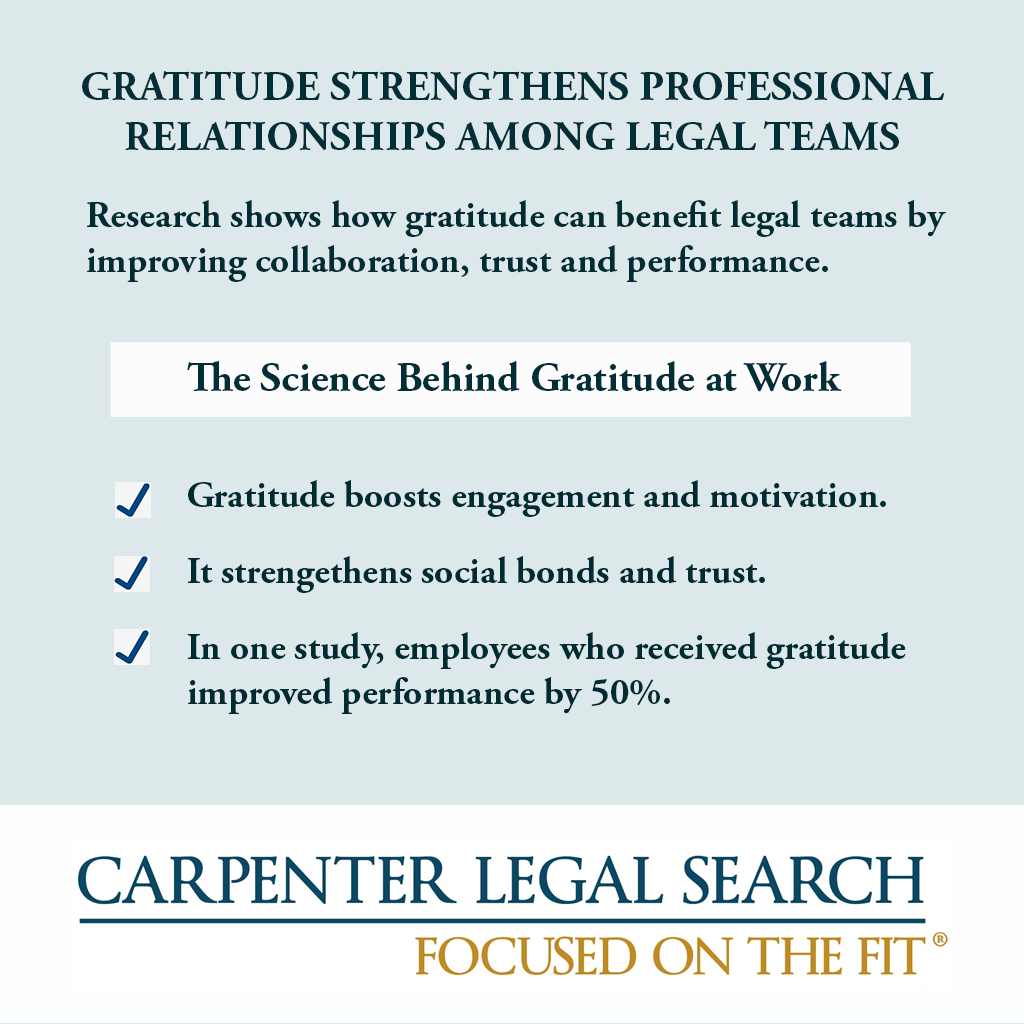How Expressing Gratitude Strengthens Professional Relationships Among Legal Teams
Research shows that gratitude isn’t just a nicety—it’s a strategic tool for improving collaboration, trust, and overall team performance.
Why Gratitude Matters in Legal Teams
Legal professionals often work under intense pressure, which can strain relationships and morale. Gratitude acts as a buffer against stress and burnout by shifting focus from adversarial dynamics to shared purpose. According to research on workplace well-being, gratitude reduces anxiety and fosters resilience—qualities essential for thriving in law practice. Moreover, expressing appreciation toward colleagues—whether for their research support, courtroom preparation, or client management—signals respect and recognition. This builds psychological safety, a cornerstone for effective teamwork in complex legal matters.
According to research on workplace well-being, gratitude reduces anxiety and fosters resilience—qualities essential for thriving in law practice.
Practical Ways to Integrate Gratitude
- Start Meetings with Appreciation: Begin team huddles by acknowledging contributions from attorneys, paralegals, or support staff.
- Personalized Thank-You Notes: Handwritten notes or thoughtful emails can have a lasting impact, as demonstrated by leaders like Doug Conant, who transformed Campbell Soup’s culture through consistent gratitude practices.
- Peer Recognition Programs: Encourage colleagues to recognize each other’s efforts, not just results. Peer recognition often has a stronger impact on morale than top-down praise.
- Celebrate Wins Publicly: Whether it’s a successful motion or a well-managed client negotiation, share appreciation in team channels or company newsletters.

The Science Behind Gratitude at Work
Gratitude is more than saying “thank you.” Psychologists define it as recognizing and appreciating the helpful actions of others and the positive aspects of our environment. Studies consistently demonstrate that gratitude enhances workplace relationships and organizational health:
- Improved Well-Being and Engagement: Gratitude at work is positively associated with higher engagement and satisfaction of basic psychological needs, which in turn boosts motivation and performance.
- Stronger Social Bonds: Gratitude fosters prosocial behaviors and strengthens interpersonal connections, creating a sense of community and trust among colleagues.
- Enhanced Collaboration and Trust: Expressing gratitude increases oxytocin levels—the “bonding hormone”—which promotes trust and cooperation in team settings.
- Performance Gains: In one experiment at the Wharton School, employees who received a message of gratitude from their manager made 50% more fundraising calls than those who didn’t, illustrating how appreciation drives discretionary effort.
Studies consistently demonstrate that gratitude enhances workplace relationships and organizational health.
The Bottom Line
Gratitude isn’t just seasonal. It’s a year-round leadership essential. For legal leaders, promoting a culture of appreciation can strengthen relationships, improve retention, and enhance overall performance. As research shows, when people feel valued, they’re more engaged, collaborative, and committed. It’s a win for individuals and organizations alike.
References
- Algoe, S. B., & Haidt, J. (2009). Witnessing excellence in action: The “other-praising” emotions of elevation, gratitude, and admiration. The Journal of Positive Psychology, 4(2), 105–127.
- Bono, J. E., & Sender, A. (2018). How gratitude influences workplace relationships. Journal of Applied Psychology, 103(5), 509–523.
- Chen, L., et al. (2024). Gratitude and employee engagement: A psychological needs perspective. Current Psychology.
- Conant, D. (2011). TouchPoints: Creating powerful leadership connections in the smallest of moments. Jossey-Bass.
- Emmons, R. A., & McCullough, M. E. (2003). Counting blessings versus burdens: An experimental investigation of gratitude and subjective well-being in daily life. Journal of Personality and Social Psychology, 84(2), 377–389.
- Grant, A. M., & Gino, F. (2010). A little thanks goes a long way: Explaining why gratitude expressions motivate prosocial behavior. Journal of Personality and Social Psychology, 98(6), 946–955.
- Lambert, N. M., et al. (2010). Benefits of expressing gratitude: Expressing gratitude to a partner changes one’s view of the relationship. Psychological Science, 21(4), 574–580.